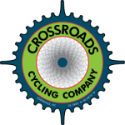The Three E-bike Classes Explained
In the United States, E-bikes fall under three classifications. The primary distinction is the maximum speed of the bicycle provided by the assist mechanism, and whether or not the bicycle is equipped with a throttle. The table below lists the three classes and the differences between them.
Class | Type | Max assisted speed | Has Throttle? | Sold by Crossroads? |
Class 1 (or Class I) | Pedal Assist Only | 20 MPH | NO | YES |
Class 2 (or Class II) | Pedal Assist with Added Throttle | 20 MPH | YES | NO |
Class 3 (or Class III) | Pedal Assist Only | 28 MPH | NO* | YES |
E-bikes are equipped with a Pedal Assist System (PAS) that is responsible for sensing when pedal assist is needed and controlling the amount of assist. There are two types of PAS:
1) Torque Sensing Pedal Assist System (PAS)
2) Cadence/Speed Sensing Pedal Assist System (PAS)
All of the e-bikes offered by Trek use a Torque sensing Pedal Assist System (PAS) and none of the e-bikes offered by Trek use the more primitive Cadence/Speed sensing system. In the Torque Sensing system, pedal assist is determined by the pressure applied to the pedals. This is a more expensive system than the more primitive Cadence/Speed Sensing system, and it provides a smoother transition and between pedal assist and no assist. This is a much better long term investment, and provides for enhanced and more efficient e-bike performance in hilly terrain, and provides for more battery range.
Class 1 e-bikes
Class 1 e-bikes use a battery and electric motor to provide assistance at up to 20 MPH when the rider is pedaling (pedal assist). Class 1 e-bikes can go faster than 20 MPH (for example, when going downhill) but the electric motor will stop providing assistance once a speed of 20 MPH is reached.Class 1 e-bikes cannot have a throttle - they can only provide assistance when the rider is pedaling.
Class 2 e-bikes
Class 2 e-bikes work in two ways. First, the electric motor provides assistance at up to 20 MPH when the rider is pedaling, just like a Class 1 e-bike. Second, Class 2 e-bikes include a throttle, which can go up to 20 MPH without the rider pedaling.On a Class 2 e-bike, the rider can pedal for fun, exercise, and fitness, but retain the ability to use the throttle for help when desired without pedaling.
Class 2 e-bikes cannot be used in some regions. Off-road trail riding locations (like mountain bike trails) often permit only Class 1 e-bikes. Class 2 e-bikes with throttles cannot be used. Class 2 e-bikes are generally considered to be electric motorcycles. Trek does not manufacture or market any Class 2 e-bikes. Because they do not require pedaling for propulsion, Class 2 e-bikes do not mix well in group rides with Class 1 and Class 3 e-bikes or traditional unassisted bicycles. Their presence in such rides presents a safety issue to the riders of traditional bicycles and riders of Class 1 and Class 2 e-bikes.
Class 3 e-bikes
Class 3 e-bikes provide pedal assist at up to 28 MPH. These more powerful electric bicycles are capable of higher speeds than their Class 1 and Class 2 counterparts. Some Class 3 e-bikes have a throttle, but most do not. When Class 3 e-bikes include a throttle, they are usually limited to 20 MPH maximum speed when using the throttle (even though the bike can go faster when the rider is pedaling).Class 3 e-bikes are primarily intended for higher-speed riding on streets and roads, making them suitable for bicycle commuters who want to arrive at work or school without breaking a sweat. They also often feature more powerful motors that produce more torque - ideal for handling headwinds and steeper hills.
You’ll find Class 3 e-bikes are commonly disallowed on bicycle paths, trails, bikeways, horse trails, and hiking trails.
